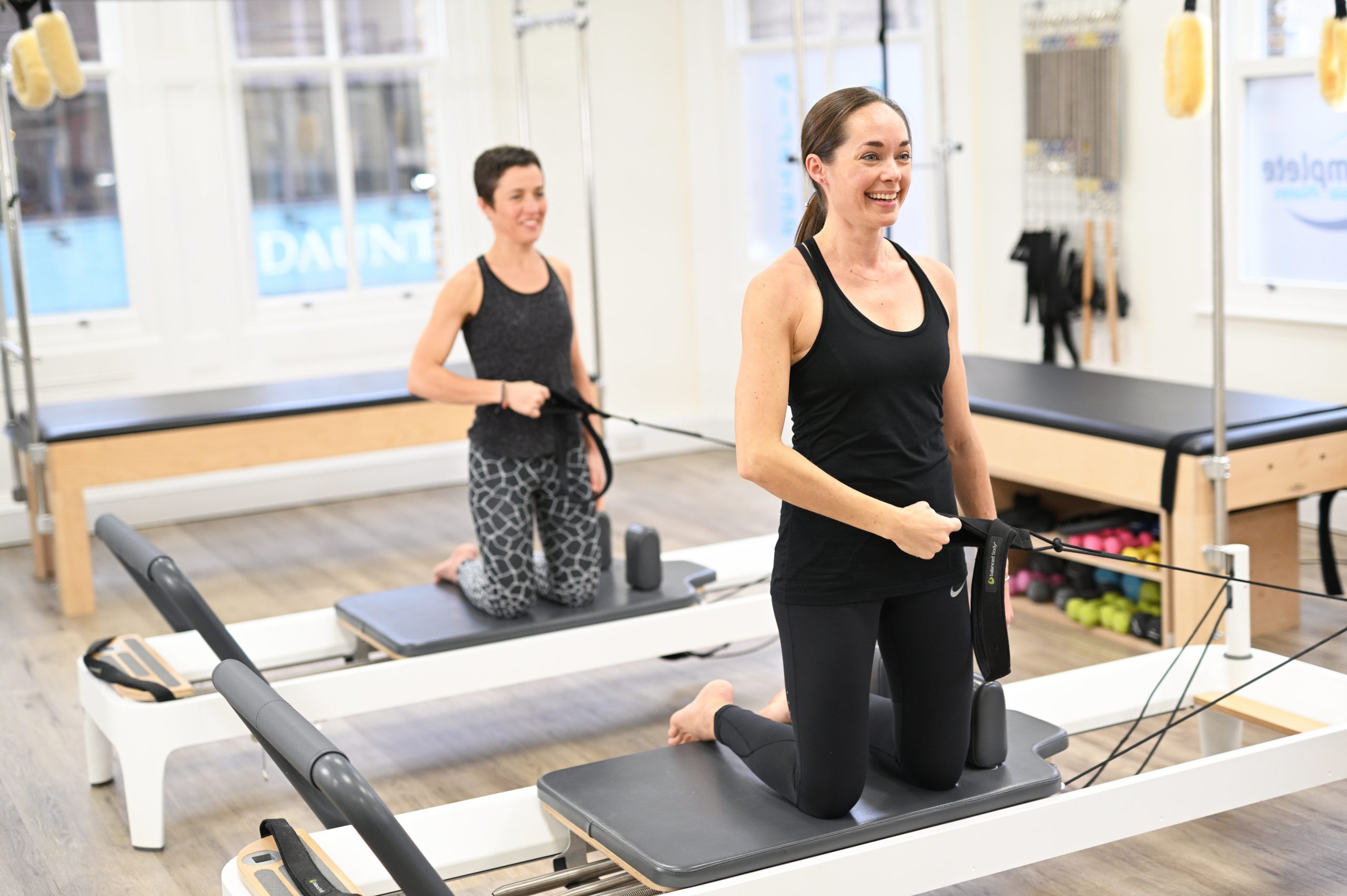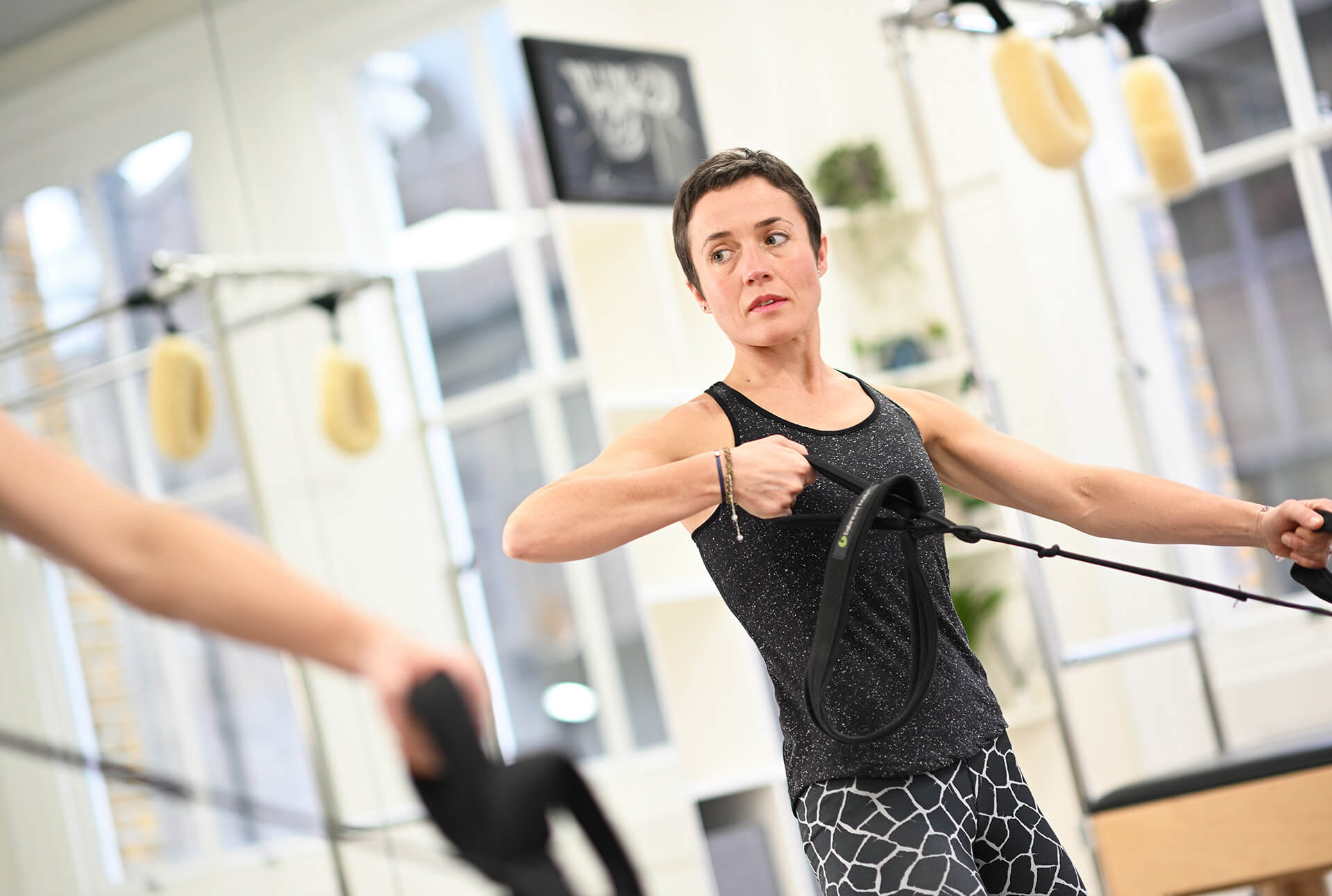In light of Breast Cancer awareness month (October), at Complete Pilates, we want to shine a light on awareness of early cancer detection, diagnosis, early treatment and rehab.
According to Breast Cancer Now, breast cancer is the most common cancer in Women in the UK. Approximately, 55,000 women and 370 men are diagnosed with breast cancer every year. That’s one woman diagnosed every 10 minutes.
25% of breast cancer cases are preventable with the right measures in place. The numbers of women surviving breast cancer are increasing each year with 90% surviving to 5 years and 50% to 10 years.
Despite the known benefits of exercise, the majority of cancer survivors are not meeting the NHS guidelines for physical activity. Cancer rehab can be beneficial to all stages of cancer care as well as prevent cancer recurrence.
In this article, we’ll be discussing how Pilates for breast cancer can act as a preventative, coping strategy for treatment and aid rehabilitation after surgery.
How does breast cancer impact the body?
Sadly, cancer does not only directly affect the part of the body it is detected in. The effects of treatment and potential surgery in breast cancer are wide-ranging affecting the whole body. Survival is the beginning; we then need to ensure that quality of life is returned. Breast cancer and its treatment can cause;
- Generalised muscle weakness
- Reduced range of movement in the shoulders and spine
- Pain
- Reduced bone density
- Neurological changes
- Fear and anxiety
- Changes to sleep patterns
- Fatigue
- Lymphoedema
These side effects can be prevented, managed and/or improved with the help of physiotherapy, exercise and clinical Pilates.

How can exercise help breast cancer?
- The effect exercise has on the body with relation to cancer is significant. If we could take exercise as a pill it would be the most commonly prescribed pill in the world. There are multiple ways in which exercise affects the body physically and psychologically which help in the fight against breast cancer.
- The exercise guidelines are the same for breast cancer as for the general population. Ideally 150 minutes per week of moderate exercise including 2-3 sessions of strength exercises.
- It has been shown in breast cancer treatment that 3 hours per week of higher intensity exercise may be more beneficial.
1. Physical activity can help reduce the risk of breast cancer by up to 30%
Physical activity lowers levels of circulating hormones such as oestrogen, androgen and insulin, and certain growth factors. Increased levels of these hormones have been associated with breast cancer. Being active also helps to support your body’s natural immune function.
It is thought that exercise also encourages other lifestyle changes that reduce the risk of cancer. The other benefit of exercise is that it helps with reducing stress levels and weight which also has a positive effect on reducing the risk of cancer.
In women, higher intensity exercise helps more and ideally should be done 3-5 hours per week. For example, dancing has been shown to reduce the risk of cancer.
2. Exercise can enhance the curative effects of cancer treatment
Exercise not only reduces the toxic side effects of cancer treatment but actually improves the therapeutic effect. This happens in a variety of ways;
- Improved blood flow and vascular structure assisting in the effect of chemotherapy drugs.
- Improved cancer cell apoptosis (cell death)
- Increased efficiency of radiotherapy

3. Exercise reduces the adverse side effects of treatment
Cancer treatment such as chemotherapy can cause negative side effects such as fatigue, reduced bone density, muscle weakness, pain and changes in our cognition.
Related reading: Exercise and Chemotherapy
Studies have shown that including exercise has a positive effect on pain levels and body composition. This means that more muscle and bone mass were maintained.
When we are fatigued we often think that we must rest and this is often encouraged in people going through cancer treatment. In fact, research shows that physical exercise can significantly reduce cancer treatment related fatigue. This effect was seen both post-operatively and during chemotherapy.
Exercise has also been shown to improve cognitive function of the brain even during cancer treatment.
In breast cancer specifically, exercise can reduce cardiac toxicity which can be caused by a particular type of treatment (endocrine therapy).
4. Exercise improves cancer prognosis
For breast cancer, regular moderate exercise can improve survival rates. This is also because exercise helps to promote other positive lifestyle changes.
Regular physical exercise can reduce the risk of death from breast cancer by up to 40%. This is the biggest effect of any lifestyle change. Exercise is the most proven method to prevent the return of breast cancer.

How can Pilates help breast cancer?
Pilates is a great form of exercise that can help breast cancer survivors. Clinical Pilates in particular, is the application of the Pilates method for medical patients.
Pilates looks at the body as a whole, not just the one area that may be affected by the disease. It can be used at all stages of care including preventative, during treatment, post operatively and throughout your recovery.
Breast cancer surgery such as mastectomy and breast reconstruction can affect the shoulder joint, spinal mobility, posture and core muscle strength.
Using the Pilates equipment in combination with home exercises on the mat and one to one advice and education from your instructor, Pilates can;
- Restore range of movement
- Increase muscle strength
- Improve breathing patterns
- Improve posture
- Improve balance
- Improve whole body coordination
- Help with mindfulness and relaxation
- Help to relieve fears and anxiety
- Increase self-care and confidence
- Improve body confidence
Pilates exercises for breast cancer
The exercises you need will be individual to you, your goals, your body and your stage of treatment for breast cancer. To establish this a one to one clinical Pilates session is best. However, the below exercises are an example of things we may work on to make sure that you have good range of movement and muscles strength through you shoulder, spine and the rest of the body. Please do feel free to give these a go.
1. Scapular movement
Scapular isolation lying on your back is a great place to start.
In this version we use a stick (or umbrella!) so that one side can assist the other.
Lie down on the floor with your knees bent and head rested, you may want to use a small pillow if it is more comfortable for you. Bring the arms up overhead with the stick in each hand.
Feel the weight of your arms into the shoulder joint and take your attention to the back of the shoulders where you can feel the shoulder blades on the floor. As you inhale reach the hands to the ceiling as if you are trying to pass the stick to the ceiling. Your shoulder blades will separate and glide around the back of your body as you do this. As you exhale relax the shoulders back towards the floor again feeling the weight of the arms into the shoulder joint and the shoulder blades flatten back onto the floor.
Repeat this X10
2. Assisted shoulder flexion
This exercise is perfect if your shoulder range of movement is restricted after surgery or treatment and can be a useful warm up and ongoing stretch for your shoulders as well. All you need is a mat and a stick (or umbrella!).
Lie on the floor with your knees bent and head comfortable, you can use a small pillow if this feels better for you.
With your arms by your side hold the stick in both hands.
Lift the arms up and overhead as far as you feel comfortable.
You can use the stick to assist if you have one side that is stiffer or weaker than the other.
Top tips
- Try and think about the arm sinking into the shoulder joint all the way through the movement.
- Keep the head heavy on the floor or cushion.
- Take note of what the rest of your body is doing and aim to reduce the movement through your ribs and spine so that you focus on the shoulder movement.
Repeat X 10
3. Side lying movement
Use this exercise to get your arm moving well out to the side and overhead!
This will work your shoulder muscles but also the small stability muscles of the shoulder – the rotator cuff. These are vital for regaining full range of movement and building strength.
Lie on your side with your head supported either by your arm or a pillow. Rest your top arm on your side with your palm to your tummy and the elbow bent to 90 degrees.
Keeping the elbow on your waist rotate from the shoulder, lifting the hand so that the palm is facing forwards and the fingers towards the ceiling. Lift the arm up maintaining that rotation and reach overhead.
Reverse the movement by bending the elbow and bringing it back to your waist keeping the back of the hand pressing back to maintain the rotation. Finally, rotate the hand forwards again to come to rest on your tummy.
Repeat X 10 each side
4. Knee hovers
This is a great way to get your arms stronger and activate the core muscles as well.
Set yourself up on all fours with the hands underneath the shoulders and the knees underneath the hips. Aim to get your spine in its natural alignment, this may look different for everyone but we aim to imagine elongation between your tailbone and the crown of your head.
As you breathe press into the feet and hands and hover the knees off the floor. The spine and head should stay in the same alignment throughout. take a breath in the position and then lower back down. You can also try to hold the position and see how many breaths you can manage whilst maintaining your hover posture!
Repeat the hovers X 10
5. Single arm weight bearing
We start to increase the challenge with this exercise to work your shoulder stability, core strength and postural alignment all at once!
Start propped up on your elbow with the knees bent and almost back in line with the hips.
Firstly practice activating the stability muscles by dropping and then lifting your waist and rib cage towards the floor. Press into the forearm and legs as you work through the shoulder, waist and glutes to lift up away from the mat.
Once you feel comfortable with this you can keep pressing the arm and lower legs into the floor and lift the hips up.
Repeat x 6 lifts each side to begin with.
Top tips 1. Imagine you are pulling your elbow towards your knees when you lift the hips, this will help you to work the underside of your body. 2. Try and keep some of the weight into your legs so that you don’t overload the upper body. 3. Maintain the neck alignment throughout so that the head is in line with the spine.
How can Complete Pilates help breast cancer survivors?
At Complete Pilates, we offer one to one assessment either in our studios or online via Zoom. We can then take you through an appropriate programme for your needs and give you advice on other forms of exercise to include. We can also advise on how to recover effectively after surgery taking into account your scars and potential further radiotherapy or chemotherapy.
We have the follow classes available:
- One to one Pilates classes
- Online Pilates classes
- On demand Pilates classes
- Pilates during cancer treatment – on demand course
These blogs are designed to give information to everyone, however, it is important to remember that everyone is different! If you have not seen one of our therapists and have any questions about injuries, what you have read or whether this may be useful to you, please just ask. We are more than happy to help anyone and point you in the right direction. Our biggest belief is that education is key. The more you understand about your injury, illness and movement, the more you are likely to improve.




